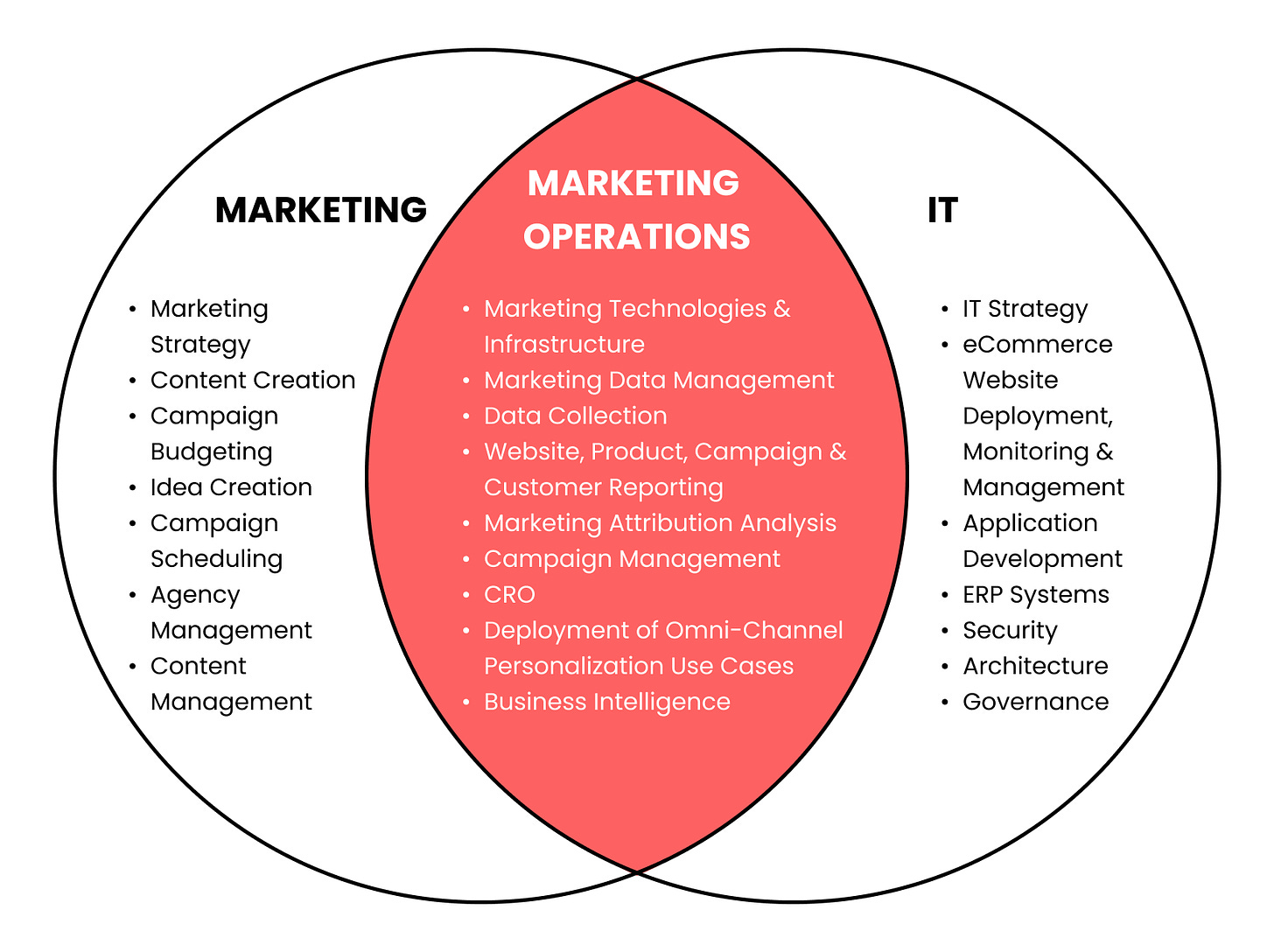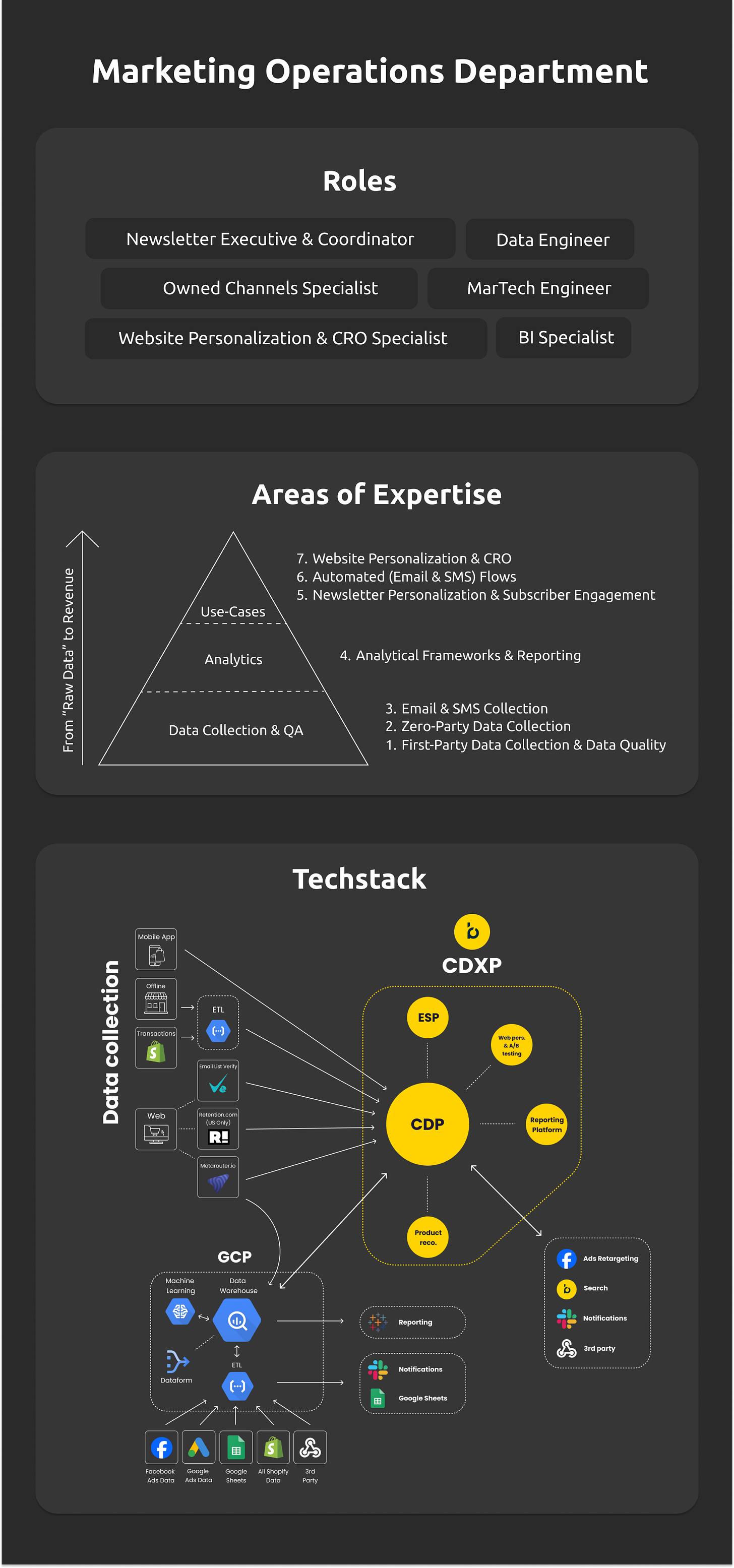Understanding the Role of Marketing Operations in eCommerce
Discover the essential areas of expertise that every marketing operations department should possess, the key roles typically within this department, and the tools they commonly use.
About the Author:
Co-founder of Datacop, agency that fulfils marketing operation roles in large eCommerce companies such as OluKai, Melin, Roark, Visual Comfort and Company, Dedoles and others.
When someone asks me what a great shopping experience looks like, I always point to the brick-and-mortar IKEA shopping experience as a prime example.
I don’t know about you, but I know many people who genuinely enjoy shopping at IKEA stores. The way they've designed their customer journey is truly remarkable.
However, I believe the IKEA in-store shopping experience has one major limitation: physical space.
It doesn’t matter whether a customer owns a house with a garden and pool in the suburbs or lives in a two-bedroom apartment in the city center—the IKEA store experience is virtually the same for both.
This is because there's only one physical version of an IKEA store, making it a static experience for every customer cohort.
eCommerce, on the other hand, offers a unique advantage. Without the constraints of a physical space, we can tailor distinct shopping experiences for different customer cohorts in the digital realm.
For example, an IKEA experience for someone living in a house with a garden and pool can focus more on outdoor furniture, while the version presented to someone living in a two-bedroom city apartment would highlight space-saving solutions.
Creating these personalized experiences across multiple channels—like email, SMS, or websites—for different customer segments in the digital space largely falls under the responsibility of a marketing operations department, which is our area of expertise.
Companies typically focus on personalized shopping experiences because it is one of the key strategies for maximizing customer retention, a responsibility that again often falls under the marketing operations department.
In this article, we’ll dive into the marketing operations department: what its main areas of expertise are, who typically works in this department, and the technologies they rely on.
So without further ado, let’s get started!
Disclaimer: We primarily work with eCommerce companies, so our description of the Marketing Operations department will be framed within the context of eCommerce businesses with annual revenues between $25M and $2B. The functions of this department may vary in other industries.
3 Pillars of the Marketing Operations Department
We believe that the Marketing Operations department is built on three main pillars:
the roles it fulfils,
the areas of expertise it covers,
and the tools (marketing tech stack) it manages.
When it comes to where the marketing operations team fits within an eCommerce company, they are typically positioned between the Marketing and IT departments.
The marketing operations team needs to have a solid understanding of both areas to bridge the gap between marketing strategies and the technical infrastructure that supports them. Below is a diagram illustrating some of the functions of the Marketing Department, Marketing Operations Department, and IT Department based on our experience.
In the sections below, we'll dive deeper into each of these pillars to give you a comprehensive understanding of the Marketing Operations department's role.
Marketing Operations Roles
Based on our experience, the Marketing Operations Department typically encompasses six key roles, each often managed by one or more individuals. These roles include:
(1) Newsletter Executive & Coordinator:
This is generally the most junior position within the Marketing Operations Department. The primary responsibility of this role is to execute regular newsletter send-outs. Typically, the Newsletter Executive receives a calendar of planned campaigns (for both email and SMS channels) that includes all creatives and copy for each campaign. Their main tasks involve creating the campaigns in the system responsible for sending newsletter campaigns, setting up the appropriate subscriber audiences, and scheduling the campaign send times.
(2) Owned Channels Specialist:
This role is the natural progression for a Newsletter Executive & Coordinator ready to take on more responsibility. In this position, the individual oversees all automations for owned channels, including cart abandonment scenarios, back-in-stock and low-in-stock notifications, and other automated workflows. They also manage email collection strategies and personalization initiatives for owned channels. The key metrics typically owned by this role are:
the size of the active subscriber base for owned channels, and
revenue per subscriber for owned channels.
(3) Website Personalization & CRO Specialist:
This role is ultimately responsible for optimizing the website experience for visitors. The primary metric they aim to maximize is average revenue (or profit) per website visitor.
Note: Revenue per website visitor is a more insightful metric than conversion rate. For example, if you raise the prices of your products, the conversion rate might decrease, but revenue (or profit) per visitor could increase. This metric provides a clearer indication of whether the price increase was a good decision.
This individual should continuously consider how the website experience should be tailored for different website visitor cohorts. Every modification to the website should be A/B tested. If the test demonstrates a positive impact on visitor behavior, the change should be implemented; if not, it should be rolled back.
This role typically collaborates with a more technical team member (in our case, a Martech Engineer) who handles the coding for more complex website personalization use cases.
(4) Business Intelligence (BI) Specialist:
This individual is responsible for analyzing the performance of various eCommerce elements, including:
the website,
products,
campaigns (both paid and owned),
and customer behavior.
This role supports owned channels specialists, website personalization and CRO specialists, as well as roles from other departments, such as performance marketers, by providing the data-driven insights necessary for informed decision-making.
(5) Data Engineer:
This individual is ultimately responsible for the quality and scope of the data collected by an eCommerce company. They define the data structure that needs to be captured, typically in the form of a tracking document (e.g., view_item and view_item_variant tracking documents), and ensure that the data is consistently and accurately collected. To achieve this, they oversee data quality processes, such as maintaining Slack notifications for monitoring data integrity.
(6) MarTech Engineer:
This role is responsible for integrating the marketing tech stack, including CDPs, email and SMS automation platforms, website personalization tools (and other marketing automation tools, as well as creating and maintaining data warehouses and pipelines between systems. It is the most technically demanding role, typically requiring strong proficiency in SQL and Python.
The Martech Engineer plays a vital role in implementing more advanced personalization use cases, typically handling the coding required for these integrations.
Areas of Expertise
Each member of the Marketing Operations department possesses expertise in one or more areas essential to their role. We categorize these into seven key areas of expertise, which we visualize as a pyramid with three levels:
Data Collection & Quality
Data Analytics
Use Cases
At Datacop, we have developed best practices for each of these areas. Perhaps surprisingly to some, we share many of these best practices free of charge through Substack articles like this one.
We ensure that all Datacop team members are trained in one or more of these areas, depending on their role.
Even if you choose to build your Marketing Operations Department entirely in-house, your team will likely need expertise in all seven areas to operate effectively.
Articles dedicated to specific areas of expertise:
First-Party Data Collection & Data Quality:
Zero-Party Data Collection:
Email & SMS Collection:
Analytical Frameworks & Reporting:
eCommerce Marketing Techstack
There are numerous alternatives for each of these tools, and we’ve been fortunate to experiment with multiple tech stack architectures. Through our experience, we’ve identified our preferred setup that, in our opinion, works best for the Marketing Operations team as a whole.
We’ve also written a dedicated article on our recommended tech stack, which you can find here:
This article examines different architectural approaches to designing an eCommerce marketing tech stack:
Final Thoughts
We believe that the marketing operations team should function as a cohesive unit, closely collaborating across all areas. From our experience with eCommerce clients, we’ve often seen separate teams handling different aspects of marketing operations with minimal communication: one team manages owned channels, another handles website experience, and a third oversees business intelligence. This siloed approach can lead to friction. For example, the owned channels team might want to include a 'subscribe to newsletter' checkbox at checkout, while the website team opposes it to maintain a clean user experience. Sometimes these teams focus more on optimizing their specific KPIs rather than considering what’s best for the overall customer experience.
We believe that this separation can result in an inconsistent customer experience across different channels, which is far from optimal. Since there is only one customer experience delivered across multiple channels, the teams should have a unified objective and work closely together to achieve it.
This is one of the reasons we favor Bloomreach Engagement as a tool. It integrates six different tools into a single platform, ensuring that all marketing operations roles work within the same system, which naturally fosters collaboration at least on some level.
Marketing Operations Department One-Pager:
For internal use, we created this one-pager that neatly summarizes all the pillars of marketing operations discussed today. If you ever need to quickly explain what the marketing operations department is all about, feel free to use this visualization.
If you found this post valuable…
We hope you found this article valuable. If so, please consider subscribing (for free!) to receive updates on our latest publications.
Additionally, if you'd like to discuss any aspect of marketing operations in more detail, feel free to book a meeting with us using the link below:



















